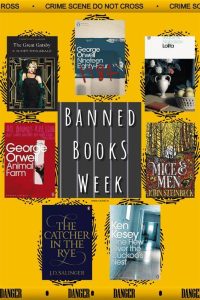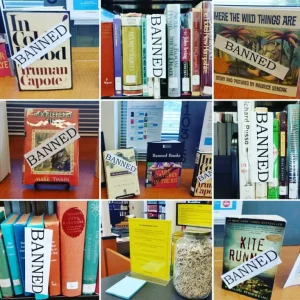Like a lot of people, I wasn’t aware that there is a week devoted to banned books. There is. It’s this week, and it began Sunday and runs to September 24.
Below I have compiled a list of the most commonly banned books according to the American Library Association. These are classics that have offended and angered people over the years.
Banned Books Week was launched in 1982 by the Banned Books Week Coalition in response to a sudden surge in the number of challenges to books in schools, bookstores, and libraries. More than 11,300 books have been challenged since 1982, according to the American Library Association. Many of those have been banned.
According to the organization’s website, the Banned Books Week Coalition is a “national alliance of diverse organizations joined by a commitment to increase awareness of the annual celebration of the freedom to read. The Coalition seeks to engage various communities and inspire participation in Banned Books Week through education, advocacy, and the creation of programming about the problem of book censorship.”
In today’s world of political correctness, where books like Huckleberry Finn and even the Holy Bible are sometimes prohibited, Banned Books Week calls attention to books that are forbidden, censored, redacted, or even edited to remove words or concepts that don’t fit a particular political or social narrative. For authors and journalists, that kind of behavior should be an abomination. It certainly is to me.
Fiction is particularly susceptible to those who censor and ban books. Themes of politics, religion, morality (or immorality), and violence are the usual triggers for those who remove books from library shelves and bookstores. In today’s cyber-connected worldwide web, banning a book is not nearly as effective as it once was—at least not in the United States.
You can find forbidden books with a click of your mouse on Amazon and in other e-book stores and download them in seconds into your e-reader. Of course, that is NOT the case in places like North Korea, China, Cuba, and other countries controlled by brutal dictators and rigid political ideologies.
Below are the world’s ten most banned books of all time, as compiled by the American Library Association. Clearly, there are many more books that have been banned, but these are the ones that are most often cited. If you haven’t read one of these banned books, you should. That’s one way to defeat those who want to control what we write and read.

Brave New World by Aldous Huxley (1932)
- The gist: Written in 1931 and published a year later, Huxley’s parody of H. G. Wells’ utopian future in his novel Men Like Gods isn’t wholly dissimilar to George Orwell’s 1984. Addressing the period’s core theme of industrialization, Huxley explored the loss of identity and increasing division of society to devastating effect.
- Why was it banned? Initially, Ireland pulled it off the shelves for its controversial themes on childbirth, before several states in the US tried to have it removed from school curriculums due to its “themes on negativity.”
The Grapes of Wrath by John Steinbeck (1939)
- The gist: Steinbeck’s Pulitzer Prize-winning novel, released in 1939, told the all too familiar story of the effects of the Great Depression on the rural poor. Focusing on a family of sharecroppers, the Joads, who were driven from their Oklahoma home by drought, economic hardship, and changes in the agriculture industry. With nowhere left to turn, they set out for California along with thousands of other “Okies” in search of land, jobs, and dignity.
- Why was it banned? Despite the book being championed by the literary elite, it was publicly banned in the US and burned en masse by the general population. People were shocked by its description of the poor, which Steinbeck later admitted was a sanitised version of what was really going on in these remote communities.
Tropic of Cancer by Henry Miller (1934)
- The gist: Set in France during the 1930s, the book follows the life of its author, Miller, who at the time was a struggling writer. Written in the first person, he wrote about his sexual encounters with friends and colleagues; it was an expose on the lives of American expats living abroad.
- Why was it banned? Almost as soon as it was released, Pennsylvania Supreme Court Justice Michael Musmanno wrote Cancer is, “not a book. It is a cesspool, an open sewer, a pit of putrefaction, a slimy gathering of all that is rotten in the debris of human depravity.” As you can imagine, people weren’t ready for what George Orwell would later call “the most important book of the mid-1930s”.
Slaughterhouse-Five by Kurt Vonnegut (1969)
- The gist: Billy Pilgrim, a disoriented and ill-trained American soldier, is captured by the Germans during the Battle of the Bulge and taken prisoner in Dresden. Housed in a disused slaughterhouse, known as “Slaughterhouse number 5”, he and the other POWs and German guards alike hide in a deep cellar, sheltering from the firestorm during the Bombing of Dresden in World War II. During this period, time begins to warp, and Pilgrim starts to see visions of the future and the past, including his death.
- Why was it banned? The good old USA thought better than to let its children be exposed to such themes, relegating it to the ranks of the American Library Association’s 100 Most Frequently Challenged books.
The Satanic Verses by Salman Rushdie (1988)
- The gist: Rushdie’s book tells the story of an Indian ex-pat living in modern-day England. After surviving a plane crash, Gibreel Farishta, a Bollywood superstar, is left to rebuild his life, while the other survivor, the emigrant Saladin Chamcha has his life torn apart.
- Why was it banned? Many in the Islamic community saw Rushdie’s take on Islam to be blasphemous. In Venezuela, you would be imprisoned for 15 months if caught reading the book, while Japan issued fines for people who sold the English-language edition. Even in the US, two major bookshops refused to sell the book after death threats were received.
The Perks of Being a Wallflower by Stephen Chobsky (1999)
- The gist: Inspired by the late J. D. Salinger’s The Catcher in the Rye, the book, published in 1999, tells the story of a teenager, “Charlie” who writes a series of letters to an anonymous friend. Charlie goes to great lengths to describe his introversion, teenage sexuality, abuse, and drug use as a teenager.
- Why was it banned? Its explicit sexual content, particularly the homosexual aspects, has led it to be withdrawn from libraries across the US and regularly makes the American Library Association’s top 10 most challenged books list.
Things Fall Apart by Chinua Achebe (1958)
- The gist: One of the most celebrated pieces of African literature, Achebe’s story of Okonkwo, a leader and local wrestling champion in Umofia – a fictional group of nine villages in Nigeria – recalls the influences of British colonialism and Christian missionaries on his traditional Igbo community during an unspecified time period in the late nineteenth or early twentieth century.
- Why was it banned? Reportedly banned in Malaysia, it is critical of colonialism and its consequences.

American Psycho by Brett Easton Ellis (1991)
- The gist: Easton Ellis’s tale of a serial killer and impeccable businessman Patrick Bateman, starts off as merely the retelling of one man’s experiences living in an affluent part of New York City during the 1980s. As the book progresses, however, the shiny veneer of Yuppie life soon reveals a far more sinister side.
- Why is it banned? Anyone who has seen the film will know why. Germany deemed it harmful to minors when it first appeared in 1991 and restricted its sales. It was banned in Canada until very recently, and it’s banned in the Australian state of Queensland and is limited to over 18s only in all other states.
The Metamorphosis by Franz Kafka (1915)
- The gist: One day, Gregor Samsa, a traveling salesman supporting his parents and sister, awakes to find he’s turned into a giant bug. Once the most beloved member of his family, so begins his estrangement from his beloved, and the rest of society, to the point where he is locked away in his room and plainly forgotten about.
- Why was it banned? All of Kafka’s work was banned under the Nazi and Soviet regimes and also in Czechoslovakia because he refused to write in Czech, using only German.
Lolita by Vladimir Nabokov (1955)
- The gist: Humbert Humbert, a scholar born in Paris, is obsessed with young women, or “nymphets,” as he calls them. Moving to a small New England town, he becomes obsessed with the 12-year-old daughter of Charlotte Haze and secretly covets her, using his marriage to her mother as a ruse. Humbert and the girl abscond and begin hopping from town to town, trying to conceal their true relationship.
- Why was it banned? After being called ‘the filthiest book, I have ever read by the editor of the Sunday Express, the Home Office seized all copies of the book in 1955 on the grounds that it was pornography. The French banned it the following year, but curiously, it was published without issue in the USA.
According to the American Library Association, the five most challenged titles in public and school libraries in 2021 were:
- Looking for Alaska, by John Green
Reasons: Offensive language, sexually explicit, and unsuited for the age group. - Fifty Shades of Grey, by E. L. James
Reasons: Sexually explicit, unsuited to age group, and other (“poorly written,” “concerns that teenagers will want to try it”). - I Am Jazz, by Jessica Herthel and Jazz Jennings
Reasons: Inaccurate, homosexuality, sex education, religious viewpoint, and unsuited for the age group. - The Curious Incident of the Dog in the Night-Time, by Mark Haddon
Reasons: Offensive language, religious viewpoint, unsuited to age group, and other (“profanity and atheism”) - The Holy Bible
Reasons: Religious viewpoint.
Wait a minute. The Bible?
Yes, that’s how bad things have become in our politically correct world.


In an ironic twist, Amazon’s first incident of electronic book banning occurred when the company “confiscated” all Kindle versions of 1984 by George Orwell, the prescient writer who warned the world of the dangers of authoritarian book banning.
My grandson is currently reading a “sanitized” version of Huckleberry Finn with the N-word and many other 19th-century terms excised from the text. Disgusting. Samuel Clemens must be livid.
When Ole Sam comes back with Halley’s comet in 2061, I hope he sues the expurgators.